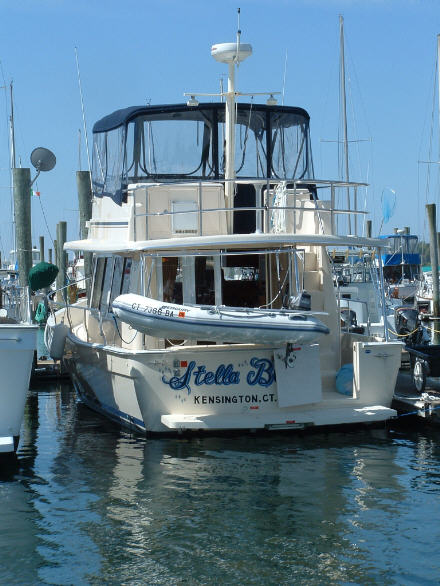Watch the dinghy loading movie!
The Stella Blue davit is a simple davit that loads and launches quickly, very cheap to build. After 10 years of using the davit, I still feel it's the best option for the 400 Trawler.

For the first year we had Stella Blue, we would stow our dink on the swim platform, and sometimes tow the dink on short trips. The problem with the swim platform location is wave action from the rear, in following seas, is destructive to the dink. Towing also has many limitations and hazards to the dink. I needed a davit system. I searched the web, and looked at hundreds of boats on the water for a better solution.
Some of the criteria for a system had to include the following:
- Must keep the dink out of the wave action
- Maintain a low center of gravity
- Provide quick and easy launch and retrieval
- Simple mechanical construction, no complex hydraulic or motorized systems to break down or maintain
- Allow full use of the transom door
- Not interfere with rear view when piloting boat
- Must not obscure the name of the boat
In reading the Yahoo Groups, Mainship discussion group posts, I found a system designed and built by Bob Hogeman for his Mainship 350, Tom Cat. It would meet all of the design requirements above, plus it would be easy to build myself.
Material & Services
|
20' |
1 1/4" SS tubing |
$60.00 |
|
2 |
Concave Deckmounts |
$9.00 |
|
2 |
Eye Ends |
$9.00 |
|
4 |
Jaw Slides |
$18.00 |
| Welding |
$100.00 |
|
|
2 |
Ronstan/Series 40 Fiddle Blocks | $131.96 |
|
2 |
Ronstan/Series 40 Blocks |
$47.98 |
|
2 |
Schaefer/ Pad Eye Welded Ring |
$23.98 |
|
100' |
Samson LS Yacht Braid - 5/16 |
$31.00 |
|
6 |
1/4" SS Hitch Pins |
$15.00 |
| Misc. Screws |
$3.00 |
|
| Total |
$448.92 |
The transom door is still usable to access my starboard finger pier at my dock. The swim ladder is not usable if the motor is mounted, but I figure the dink will be in the water when we go swimming anyway.
This is about where I expect the water level to be when launching. All I need to do is make some proper lifting straps. Below are some more pictures of more detail.
Here is a little more detail on the working end of this rig. The Ronstan fiddle blocks have a 4:1 purchase which makes light work of raising the dink. The blocks have a 770 lb. working load rating, which is way more than you need, but it allows you to use larger line which is easier on the hands. Someone asked about how to make fast the line when raising the dink. The picture below shows a closeup of the camcleat setup on the blocks. By pulling down on the line the line slipd into the camcleats and is secure until you pull on it again. By lifting the line towards the top of the block, the line comes out of the camcleat and then the line can be feed back through the block to lower the dinghy. They use these all the time on sailboats.
The block is fastened to the bridge support tube by a Schaefer padeye which is screwed to the tube with 1/4-20 machine screws. The rest of the rig is mostly bimini top hardware. I just modified some of it for larger screws and pins.
DAVIT UPDATE
When I upgrade the dinghy size and motor, I decided to beef up the davit. I went to heavier wall tubing (.08 min) and used a formed radius at the corners rather than a welded construction. A click here for a drawing of the rough dimensions. I retained all the mounting hardware. I did put the dinghy hanging hardware on the bow before forming the radius, just in case the tube went slightly out of shape when bending.

Trim the bottom end of the tube so it will swing under the flybridge edge.

Click this link to get to the dinghy cover page.





